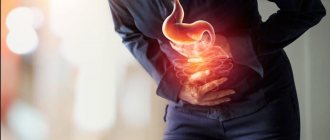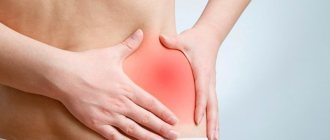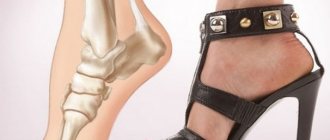We asked Larisa Tretyakova, gastroenterologist, doctor of the highest category, head of the department of the PharmMed Clinic , to tell us what most often hurts in the epigastric area, how to understand your own sensations and what diagnostic procedures are necessary in this case.
Almost every resident of a big city has experienced pain in the upper abdomen - right in the triangle under the ribs. Most often, epigastric pain indicates diseases of the digestive system.
Let's first figure out exactly what organs are located here. This is the stomach that passes into the duodenum. To the left of the stomach is the pancreas, which is responsible not only for digestion, but also for hormonal control - in particular, it produces insulin, which cells need to absorb nutrients. The spleen is also located here, which is responsible for purifying the blood and functioning of the immune system. To the right of the stomach the gallbladder and liver are densely packed. All of these organs (with rare exceptions) can be a source of pain localized in the epigastric region.
The Deepest Essence of Digestion
Every high school student knows that digestion occurs in the stomach. Aggressive hydrochloric acid attacks the food entering the stomach, and it begins to break down into easily digestible components.
| Not often, but it happens | |
| Epigastric pain may be a signal of myocardial infarction. After all, in the area of the solar plexus there are not only the digestive organs - the lungs and heart are nearby. So you should not tolerate acute abdominal pain. If it doesn’t work, call an ambulance. In addition, epigastric pain may be of neurological origin. That is, in the thoracic spine, one or another nerve is sandwiched between the vertebrae - and the signal is transmitted along the nerve to the stomach. A neurologist will be able to “decipher” such pain after an X-ray or CT scan of the spine. | |
But not every school graduate knows that a person without a stomach can live relatively normally. Because only the first stage of digestion takes place here. Much more important processes occur in the next “compartment” - the duodenum. The pancreatic ducts and the common bile duct exit here.
The gall bladder accumulates bile produced by the liver, and as soon as food enters the duodenum, the bile is sent there to help with digestion. An equally important role in digestion is played by the so-called “pancreatic juice” - the secretion of the pancreas, which also enters the duodenum through the ducts.
After food is “processed” in the duodenum, it is sent for further digestion and absorption in the small intestine.
img3_0.png
Often, rare and short-lived pain in the upper abdomen is the result of a violation of the diet and errors in diet. To eliminate this unpleasant symptom, it is recommended to regulate the frequency and timing of meals, observing the appropriate rules of eating behavior. Fractional meals in small portions, 4–6 times a day, have worked well. Dinner should take place at least 3 hours before bedtime. You should also limit your intake of foods that are difficult to digest and maintain fluid balance (drink water on an empty stomach and between meals).
Gastritis, ordinary and not very
The most common disease that causes pain in the epigastric region is gastritis, that is, inflammation of the gastric mucosa. Depending on the nature of the disease, gastritis can be acute or chronic.
The danger of chronic gastritis is that most cases of stomach cancer develop against the background of a long course of this seemingly harmless disease.
The type of gastritis is divided into superficial gastritis, in which only the mucous membrane becomes inflamed, and atrophic - in this case, against the background of inflammation, the stomach glands that produce hydrochloric acid gradually die.
| How can you examine the stomach? | |
| Unfortunately, not every person can safely undergo gastroscopy. The test is not a pleasant one. Therefore, now one of the most common (albeit paid) services is gastroscopy in a dream. If you have no contraindications to general anesthesia, then you can sleep through the entire examination with a clear conscience and not get negative impressions. Another innovative research method involves the patient swallowing an endoscopic capsule. A small device goes on a journey through the digestive tract and “makes a movie” along the way. Due to the fact that such a study is the least traumatic and most informative (the esophagus, stomach and entire small intestine are examined), it costs much more than all alternatives. | |
Unfortunately, it is possible to identify the type of gastritis and, accordingly, decide on treatment only after an examination, colloquially called “gastroscopy” - during this procedure, an endoscope is inserted into the upper parts of the gastrointestinal tract.
In fact, the study is called “esophagogastroduodenoscopy”, because during the procedure the doctor examines the patient’s esophagus, stomach, and duodenum. It is very important to carry out this study in as much detail and quality as possible, since gastritis very often “adjacent” to duodenitis (inflammation of the duodenum) and pathology of the esophagus.
When you need medical help
You need to seek emergency help if:
- The pain is very strong and does not subside after taking the pills for an hour.
- During pregnancy.
- The stomach has become hard, the muscles on it are tense.
- The attack is accompanied by nausea, vomiting, bleeding from the vagina, rectum, and ureter.
- The temperature rose.
You should not neglect contacting a doctor even with less severe symptoms. An examination using ultrasound, MRI, and laboratory tests will help you understand why your stomach is bothering you. The list of diagnostic methods and measures for treatment will differ in many ways for different diseases. You can start by consulting a therapist or immediately contact a specialist if you suspect a specific disease.
Children's and Children's Center "Kutuzovsky" is a multidisciplinary clinic where doctors of various specializations are ready to see you seven days a week. Sign up online for a convenient time and come to the address: st. Davydkovskaya, 5. We will find the cause of disturbing symptoms and how to help in any situation.
The contents of this article have been checked and confirmed for compliance with medical standards by general practitioner Yulia Vladimirovna Butskikh.
Pancreatitis is a threat to life
Acute pain in the epigastrium can be a symptom of pancreatitis - inflammation of the pancreas. This organ can sluggishly signal a problem with regular, mild pain. And this means it’s time for an examination.
But if the pain in the epigastrium has become almost unbearable, plus stool disturbances and vomiting develop, in some cases an increase in temperature, then this means acute pancreatitis. And this is an indication for urgent hospitalization.
Pancreatitis usually occurs when pancreatic secretions (pancreatic juice) stagnate. The duct that should carry secretions into the duodenum is blocked by a stone, cyst, swelling or pus. But the juice continues to be produced and enthusiastically digests the gland itself. Therefore, in acute pancreatitis, delay is literally death.
Oddly enough, pancreatitis often attacks young people who lead an active lifestyle, love to eat, sometimes drink, and, most importantly, are subject to constant stress.
| Interesting! | |
| Vegetarians are less likely to suffer from peptic ulcers than people who eat meat. If the "ulcer" increases the fiber content in the diet, this will reduce the frequency of exacerbations of the disease. Lately, doctors have been “prescribing” fiber even during exacerbations of ulcers. | |
Problems with the pancreas can be diagnosed in advance - before the development of acute pancreatitis - using a simple ultrasound and blood test. If an ultrasound shows any problems with the pancreas, the doctor may prescribe a computed tomography scan - a study that gives a layer-by-layer image of the gland and allows you to examine in detail the essence of the problem.
Causes of epigastric pain
Functional dyspepsia
Epigastric pain is provoked by errors in the diet, abuse of fast food and dry food.
Unpleasant symptoms usually occur during stress, travel and time zone changes. The pain is aching or nagging and has moderate intensity. Less commonly, patients report a sharp stabbing sensation in the upper abdomen. Such manifestations are observed periodically under the influence of predisposing factors. Along with the pain syndrome, a feeling of heaviness and fullness in the epigastrium, nausea, and heartburn increase. Characteristic belching is air, which develops as a result of aerophagia. With functional stomach disorders, gastrointestinal symptoms are accompanied by disorders of the autonomic nervous system. Characterized by pallor and coldness of the extremities, increased sweating, increased heart rate.
Gastritis
Gastritis with high acidity is characterized by sharp pain in the upper abdomen, which intensifies 20-30 minutes after eating and lasts for several hours. With gastritis with low acidity, there is a constant dull or aching pain that is not associated with food intake. After finishing a meal, patients complain of heaviness in the epigastrium, nausea, and belching.
In the acute form of gastritis or exacerbation of the chronic process, pain appears sharply against the background of errors in diet and alcohol intake. The pain syndrome can be very strong, reminiscent of an “acute abdomen”. Chronic gastritis is characterized by periodic moderate pain, accompanied by changes in stool, belching, and heartburn. Due to impaired iron absorption, pale skin, weakness, and dizziness occur.
Peptic ulcer
A stomach ulcer is manifested by severe pain in the epigastric region, which appears immediately after eating food, accompanied by nausea and heartburn. To relieve discomfort, patients induce vomiting. With a complication of a peptic ulcer - perforation of the ulcer - a “dagger pain” is suddenly felt in the upper abdomen. The person lies motionless with his legs pulled up to his stomach, since the pain intensifies with movement.
Pain in the upper abdomen
Pyloric stenosis
In the compensated stage, dull and bursting pain occurs in the epigastrium after a heavy meal, combined with a feeling of heaviness in the stomach and belching. With decompensation of pyloric stenosis, constant severe pain in the upper abdomen is noted, worsening after finishing eating. Vomiting begins with foods eaten the day before, after which the state of health improves for a short time.
Pancreatitis
In the acute course of pancreatitis, the pain is localized in the epigastric part and left hypochondrium, and has a girdling character. Unpleasant sensations intensify when lying on your back. The appearance of a painful attack is typical for heavy drinking. The pain is accompanied by repeated vomiting, which does not bring relief to the patient. Possible increase in body temperature, slight yellowness of the sclera.
Chronic pancreatitis is characterized by discomfort in the upper abdomen, occasionally radiating pain to the heart area. When following a diet, pain is rarely a concern; it is moderate and short-lived. Pancreatitis occurs with exocrine pancreatic insufficiency, so the pain syndrome is accompanied by steatorrhea, lienterea, and flatulence.
Cholecystitis
With inflammation of the gallbladder, pain is localized in the upper abdomen and right hypochondrium. Symptoms are associated with consumption of fatty foods. In chronic cholecystitis, pain in the epigastrium is aching in nature, accompanied by heaviness in the abdomen and changes in stool. Acute cholecystitis is characterized by sharp, paroxysmal pain in the upper abdominal cavity. The clinical picture is complemented by vomiting with bile, yellowness of the skin and mucous membranes.
Hernias
A diaphragmatic hernia is manifested by severe pain in the retrosternal region and epigastrium, caused by compression of the stomach in the hernial sac. The symptom is provoked by physical activity, prolonged coughing, and vomiting. Increased pain occurs when the body bends forward and strains. In addition to the pain syndrome, constant heartburn is a concern, which gets worse after eating and when lying down. With large diaphragmatic hernias, shortness of breath is observed.
A rarer cause of epigastric pain is a hernia of the upper part of the linea alba. Characterized by constant aching sensations in the upper abdominal cavity, which do not have a clear localization. Symptoms are aggravated by physical activity and straining. A typical symptom of this pathology is the appearance of sharp pain when trying to raise your legs while lying on your back. Occasionally, a protrusion of soft elastic consistency can be felt in the middle of the epigastric region.
Intestinal infection
Epigastric pain is characteristic of food poisoning, which occurs with gastritis or gastroenteritis syndrome. They are often caused by rotaviruses, enteroviruses, and staphylococci. Symptoms appear within a few hours to 1-2 days after eating food of questionable quality. Suddenly, severe pain occurs in the abdominal cavity with nausea and repeated vomiting. Then comes watery diarrhea.
Neoplasms
With benign formations (polyps), periodic dull pain develops in the upper abdomen, not associated with food or other external factors. Stomach cancer is characterized by constant increasing pain in the epigastrium, which is not relieved by conventional analgesics and antispasmodics. In addition to pain, there is a deterioration in appetite and a change in taste preferences, as a result, patients rapidly lose weight.
Respiratory damage
Pain in the upper abdomen occurs with lower lobar lobar pneumonia, dry and exudative pleurisy. The irradiation of pain is determined by the proximity of the organs of the thoracic and abdominal cavities and their common innervation. The pain is dull or aching in nature, intensifies with deep breaths, coughing, and turning the body. The symptom is combined with high fever, shortness of breath, and lag of half of the chest when breathing.
Myocardial infarction
Severe epigastric pain occurs with the abdominal form of myocardial infarction. The pain syndrome develops suddenly, often preceded by emotional shock. The pain is accompanied by severe weakness. The skin becomes pale and covered in cold sweat. The pain is so severe that the patient is in a pre-fainting state.
Intercostal neuralgia
With damage at the level of the lower ribs, pain may radiate to the epigastric zone. The sensations are sharp and shooting, localized on one side. They occur when the body is in an awkward position, after bending or turning the body, or after staying in one position for a long time. The pain intensifies when you feel the intercostal spaces or try to bend in the opposite direction.
Complications of pharmacotherapy
A typical iatrogenic cause of upper abdominal pain is NSAID gastropathy. The disease is characterized by periodic discomfort in the epigastrium, which intensifies at night and on an empty stomach. There is a decrease in appetite, nausea, and flatulence. About 40-50% of gastropathy is asymptomatic and manifests itself with sharp pain in the projection of the stomach with the development of complications - perforated ulcers, gastrointestinal bleeding.
Rare causes
- Damage to the spleen
: splenomegaly, abscess or cyst of the spleen, perisplenitis. - Rare gastric diseases
: acute dilatation of the stomach, gastric volvulus. - Kidney diseases
: pyelonephritis, renal colic. - Vascular pathologies
: portal vein thrombosis, abdominal aortic aneurysm, ischemic abdominal syndrome. - Intoxication
: nicotine, morphine, heavy metals (lead, mercury). - Psychogenic conditions
: hysteria, masked depression, somatoform disorder.










